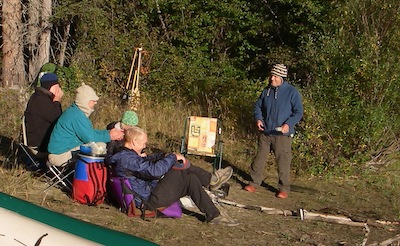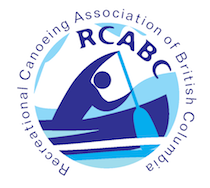
Canoeing on lakes and rivers with a group requires some structure if you want to reduce risk and build a sense of teamwork. How far apart your group is and what kind of formation you travel in should be planned. How many canoes are a safe number and have you ever gone or thought about going on a solo trip?
GROUP TRAVEL TOPICS:
- NUMBER OF CANOES ON A TRIP
- GROUP SPACING AND OTHER RECOMMENDATIONS
- FORMATION
- SIGNALS & COMMUNICATION
RCABC recommends traveling in groups with a minimum of 3 canoes. This allows for greater flexibility during rescues or emergencies. For example during a rescue, the third canoe can help stabilize the rescue canoe or collect floating gear to speed up the rescue. There are times when too large a group can become a hazard. It becomes more difficult to keep track of everyone, particularly with how the paddlers are managing with their comfort, personal needs, hunger, injuries and so on. Sometimes it is beneficial to split a large group up into smaller groups, each with their own structure and plan. This can be particularly important on rivers or waterways that have small landing spots. Also consider your impact on wildlife such as nesting birds in the spring and early summer. A large group of canoes can cause considerable disturbance if travel and sites are not chosen carefully.
Solo trips are something that many canoeists dream off and occasionally do. If you choose to travel alone, it is important that you understand that there is a significantly increased risk. Take extra precautions by outfitting your canoe and yourself well. Learn the limitations of doing self rescues and how far you can swim to shore towing your canoe. Be extra cautious while camping.
GROUP SPACING AND OTHER RECOMMENDATIONS
Distance between canoes cannot be easily defined. It depends on the type of waterway and the current conditions.
- Keep the group together, within communication and quick rescue distance.
- Being too close together can be a hazard in wavy lake conditions.
- Being too close together on a river can be even more dangerous.
Travel close to shore in case there are sudden weather changes and consider your longer crossings carefully. Shorelines offer more scenic interest and wildlife viewing opportunities.
Group formation is the shape of your group such as a line or a pod. There are times when the formation should be carefully considered:
- crossing large bodies of water
- canoeing in high boat traffic areas
- running rivers
- challenging rapids
- worsening weather
- and more...
There are many potential options but generally pods are good for lake and ocean travel and lines (single file) are good for river. For challenging rapids, one at a time is highly recommended. On open bodies of water a line where everyone is side by side helps keep people together and is great for communication.
Assigning strong canoeists to the lead and a sweep (front and back of the group) positions is a great way to organize a group, particularly if there are inexperienced paddlers. Place inexperienced paddlers in the middle. The lead can determine the route and pace and the sweep has a great view of the group and is often best suited to do rescues and help anyone that is struggling. Paddlers can alternate as lead and sweep and it is a great opportunity to give inexperienced paddlers some time in positions of 'responsibility' during good paddling conditions.
Communication is vital to managing risks. These are the typical methods of communication:
- Paddle signals - these are universal and most trained canoeists, kayakers and rafters use roughly the same signals.
- Whistle blasts - whistle signals can vary from group to group but three whistle blasts always means help or emergency
- Hand signals - used more for river rescue but can also be used in other situations
- Radio - sometimes groups carry VHF radios for line of sight communication, often between the lead and sweep canoes
- Emergency Services signals - see the section on emergency communication [link coming soon]
It is vital that signals be passed along so the entire group sees them and returns them.



















